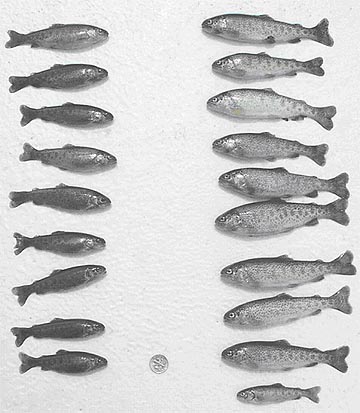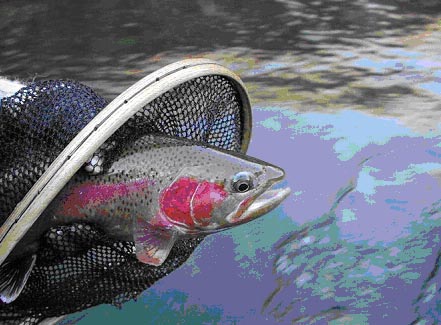Whirling Disease Resistant Rainbow Trout Broodstock Development
George J. Schisler, Ph.D. Principle Investigator
Identification and use of resistant strains of rainbow trout is a management technique that may be successful in reestablishing wild rainbow trout populations where they have been lost due to Myxobolus cerebralis, the parasite that causes whirling disease. Resistant strains of rainbow trout stocked as M. cerebralis-negative fish will also develop lower myxospore counts after release into infected environments. In both of these situations, reduction in ambient M. cerebralislevels in the wild will occur through the use of less susceptible rainbow trout strains.
One of our goals is to establish brood stock of candidate rainbow trout strains resistant to infection by M. cerebralis and evaluate these strains under laboratory and field conditions. We are currently in the process of evaluating and selecting these strains. The Hofer rainbow trout strain has demonstrated strong resistance to the parasite. These fish originated from the Kamloops rainbow trout in the Columbia River system in North America. In the late 1800's these fish were transported to Germany to be grown as food fish in local hatcheries. Because whirling disease is endemic in Germany, the fish were reared in whirling disease-positive waters. Over time, this rainbow trout strain developed a resistance to the parasite. This resistance has been confirmed in laboratory studies.
Because of their long history of domestication, the Hofer rainbow trout are a very fast growing fish (Figure 1). We are currently evaluating the pure Hofer rainbow trout in our hatchery system to determine if they will be useful as a standard domestic strain, used for put-and-take waters where fish are stocked at catchable size for immediate harvest by anglers. The Hofer rainbow trout have typical behaviors associated with domestic fish, which include reduced fright response and aggressive feeding. These characteristics of domestication, while beneficial in a hatchery setting, are not advantageous for wild fish.
In fish that are to be used in wild trout waters, we are breeding the resistance of the Hofer rainbow trout into the Colorado River rainbow trout strain. Rainbow trout are not native to Colorado, and the Colorado River rainbow trout is a wild strain that is a result of Federal, State and private stocking in the early 1900's in Colorado. This strain did very well in rivers in Colorado until the spread of whirling disease. The Colorado River rainbow trout strain is highly susceptible to the parasite. Our breeding program is designed to retain the maximum wild genes possible in the new broodstock, while conferring resistance to whirling disease to this strain. This will help maintain wild behavior in the fish, and result in more successful natural spawning and survival.
In each generation of crosses, the offspring are exposed to heavy doses of M. cerebralis to identify resistant family lines and individuals (Figures 2 and 3). Only families of resistant offspring and individuals demonstrating resistance are used in subsequent crosses. These fish will be back-crossed with pure Colorado River rainbow trout to reduce the amount of domesticated Hofer genes in the new broodstock. Using this method over several generations will produce fish that are both resistant to whirling disease and capable of natural reproduction and recruitment in the wild (Figure 4).
Figure 1. Tasmanian rainbow trout (left) and Hofer rainbow trout (right) grown under the same conditions at three months of age. The Tasmanian rainbow trout are a standard domestic rainbow trout strain used in hatcheries. The Hofer rainbow trout are a rapidly-growing domestic strain with strong resistance to whirling disease.

Figure 2. Results of M. cerebralis exposure tests. Myxospore count is a measure of infection severity. Each individual icon represents results from a family of ten fish. The Colorado River rainbow trout show high infection levels, the pure Hofer rainbow trout show strong resistance to the parasite, and the crossed fish show variable resistance depending on individual family.

Figure 3. Broodstock selection for resistant offspring of Hofer rainbow trout crossed with Colorado River rainbow trout. The fish on the top shows resistance to the parasite, while the fish on the bottom is severely affected by the parasite. The fish on the top is retained for the next generation of crosses.

Figure 4. Wild rainbow trout. Continued backcrossing of whirling disease-resistant family lines of Hofer x Colorado River rainbow trout with Colorado River rainbow trout will produce wild stocks of rainbow trout with resistance to whirling disease. Hopefully, these stocks will be capable of successful natural reproduction and survival in rivers where populations have been lost due to whirling disease

Photo by Kevin Rogers, CPW

